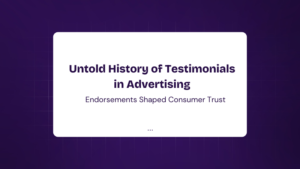The Magic of Word-of-Mouth—But Make It Digital
Imagine you’re about to buy a new smartphone. You’ve seen flashy ads, influencer endorsements, and even that over-the-top commercial where a guy skydives while streaming live. But then, your best friend says, “I just bought this phone, and it’s amazing!” Suddenly, that recommendation holds more weight than all the million-dollar ads combined.
That’s the power of testimonial advertising—a modern spin on good old-fashioned word-of-mouth marketing. It’s not just about throwing celebrity faces on a product (although that works too); it’s about using real customer experiences to build trust, credibility, and, ultimately, sales.
But how do these ads work, and why do they tap so effectively into consumer psychology? Buckle up, because we’re diving deep into the world of testimonial ads—armed with research, examples, and data that prove why this strategy is a marketing goldmine.
What Are Testimonial Ads?
Testimonial ads are marketing campaigns that feature real customer experiences, expert endorsements, or influencer recommendations to promote a product or service. These testimonials act as social proof, reassuring potential buyers that they’re making a sound decision.
They can take various forms, including:
- Written reviews (e.g., Amazon or Yelp reviews featured in ads)
- Video testimonials (e.g., customer success stories on YouTube)
- Celebrity endorsements (e.g., Nike featuring LeBron James)
- Influencer partnerships (e.g., Instagram influencers showcasing beauty products)
- Case studies (e.g., brands using detailed success stories to prove their effectiveness)
The idea is simple: people trust people more than they trust brands. If a happy customer vouches for a product, it carries far more weight than a brand tooting its own horn.
Why Testimonial Ads Work: The Science Behind Trust
So, why do testimonial ads work so well? The answer lies in psychology.
Social Proof (We Follow the Crowd)
According to Robert Cialdini, author of Influence: The Psychology of Persuasion, social proof is one of the strongest motivators in decision-making. When people see others enjoying a product, they’re more likely to believe it’s worth their money.
🔹 Example: Ever wondered why Apple features user testimonials on its website? It’s because seeing other happy customers makes new buyers feel more confident in their decision.
Emotional Connection (Relatable & Authentic Stories Sell)
Research by Nielsen shows that 92% of consumers trust peer recommendations over traditional advertising. Testimonials often include personal stories, making them more relatable and emotionally compelling than scripted ads.
🔹 Example: Weight-loss brands like Weight Watchers use real-life success stories because emotional storytelling makes the results feel achievable.
The Halo Effect (Famous People = Better Products?)
The halo effect is a cognitive bias where we assume that if a person is trustworthy in one area, they must be trustworthy in others. This is why celebrity endorsements work so well.
🔹 Example: When Michael Jordan partnered with Nike for Air Jordans, sales skyrocketed. People associated Jordan’s greatness with the shoes—whether or not they played basketball.
Types of Testimonial Ads & How Brands Use Them
Customer Testimonials (The Everyday Hero Approach)
This is when brands feature real customers sharing their success stories. These testimonials feel authentic and relatable, making them highly persuasive.
🔹 Example: Slack, the workplace messaging app, showcases businesses explaining how Slack improved their productivity. This makes potential users think, “If it worked for them, it’ll work for me too.”
Influencer Testimonials (The Social Media Power Play)
Influencer marketing is essentially modern testimonial advertising. Social media influencers share their experiences with products, and their followers trust their recommendations.
🔹 Example: Gymshark collaborates with fitness influencers who wear and review their apparel, creating a massive community of loyal customers.
Expert Testimonials (The Authority Advantage)
Sometimes, brands use industry experts to validate their product’s effectiveness. This works particularly well in health, technology, and finance.
🔹 Example: Colgate often features dentists in their ads with the famous line: “9 out of 10 dentists recommend Colgate.”
Celebrity Testimonials (Star Power Sells)
Using celebrities can instantly boost a product’s credibility and appeal. While it’s expensive, it often results in high ROI (Return on Investment).
🔹 Example: Pepsi has used celebrities like Beyoncé, Britney Spears, and Kendall Jenner to boost brand image and sales.
How to Create High-Converting Testimonial Ads
Now that we know testimonial ads work, how do brands craft them effectively?
Keep It Authentic
Fake or overly scripted testimonials can backfire. Ensure the story feels real.
Highlight Specific Benefits
Instead of vague praise (“I love this product!”), show real results (“This software saved us 10 hours a week on reporting!”).
Use Multiple Formats
Combine text, video, and social media testimonials for maximum impact.
Feature Diverse Testimonials
Different demographics resonate with different audiences. Showcase variety.
Add Visual Proof
Before-and-after images, screenshots, and stats make testimonials more convincing.
The Future of Testimonial Advertising: What’s Next?
As digital marketing evolves, so do testimonial ads. Emerging trends include:
- AI-Powered Testimonial Curation: Companies are using AI to analyze and showcase the most persuasive customer testimonials.
- Augmented Reality (AR) Testimonials: Brands may soon allow users to experience testimonials interactively.
- Micro-Influencer Testimonials: Brands are shifting towards smaller, highly engaged audiences rather than mega-celebrities.
🔹 Example: Beauty brand Glossier heavily relies on user-generated content (UGC) from micro-influencers, creating a strong community-driven marketing approach.
FAQs
Are testimonial ads better than traditional ads?
They are often more effective because they leverage trust and authenticity, which traditional ads sometimes lack.
Can small businesses use testimonial advertising?
Absolutely! Even a single Google review or Instagram shoutout can serve as a powerful testimonial.
Do testimonial ads work in B2B marketing?
Yes! Case studies and customer success stories are a staple in B2B testimonial marketing.
How do I get customers to provide testimonials?
Offer incentives, request feedback, and make it easy for customers to share their experiences.
Are video testimonials more effective than text?
Yes! Studies show that video testimonials have a 95% retention rate, compared to 10% for text.
Why Testimonial Ads Should Be Your Go-To Strategy
In a world where consumers are bombarded with marketing messages, testimonial ads cut through the noise by offering authenticity, relatability, and trust. Whether it’s a written review, an influencer endorsement, or a powerful customer story, testimonials humanize brands and drive real sales.
So, next time you see a glowing customer review featured in an ad, remember—it’s not just marketing. It’s the science of trust in action.



